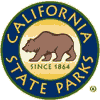|
REDWOOD
The Redwood State Parks |

|
PALO COLORADO
For two thousand years, Indian tribes lived near the huge trees but seldom ventured into the dark forests. The Yuroks lived on the lower Klamath River and nearby coast; their culture has a marked respect for wealth and private property, similar to others which flourished from Central Oregon to Alaska. The Yuroks lived in dwellings fashioned from redwood planks, made redwood dugout canoes, and generally took full advantage of the redwood forest riches. Fortunately, there was usually an adequate supply of wood from trees which fell from natural causes, since it was a real challenge to fell a redwood without iron tools. The Indians would sometimes build fires around the base of a tree to bring it down so they could reach the acorns hidden by woodpeckers in holes in the trunk.

|
| A Yurok dwelling in Humboldt County. (Department of Parks and Recreation) |

|
| A Yurok sweat house. (Department of Parks and Recreation) |

|
| Hollowed-out redwood logs were made into canoes. (Department of Parks and Recreation) |
The Pomos, who lived in the area between Fort Bragg and Fort Ross, were famous for their basket-making techniques. Though they used redwood bark for their lean-tos, the redwoods were not otherwise important to them. They lived by fishing, hunting, and seed gathering along the open slopes of the coast range. They seem to have been a peaceful people, with a social organization which gave everyone in a village an equal right to hunt and fish on the communal lands, and gave authority to the village chief.
Though the first foreigners to see the coast redwoods may have been the crew of a venturesome Chinese ship, Fray Juan Crespi, a Franciscan missionary who accompanied the Portola expedition traveling overland up the coast from San Diego, gives the first recorded sighting. In his journal entry for October 10, 1769, Fray Crespi noted that the coastal plains and low hills were "well forested with very high trees of a red color, not known to us. . .In this region there is a great abundance of these trees, and because none of the expedition recognizes them, they are named Palo Colorado (red tree) from their color."
Early travel through the dense, mountainous coast redwood forests was difficult. In 1828, when a party of explorers led by Mountain Man Jedediah Smith traveled from the Sacramento Valley to Oregon via the upper Trinity River and through Humboldt and Del Norte Counties, the group sometimes made only a mile a day. Scarcity of game in the dense forests and hostile indians were other problems. But after 1850, gold fever spurred exploration.
Explorers led by Joseph R. Walker encountered the Sierra redwood in 1833, but it was not until 1852 that it came to the attention of the world. A. T. Dowd, a hunter, stumbled into the Calaveras North Grove while tracking a wounded grizzly. His companions refused to believe that there could be trees as large as he described, and at first wouldn't even go to look at them.
| <<< Previous | <<< Contents>>> | Next >>> |
state-parks/sec2.htm
Last Updated: 14-Oct-2011